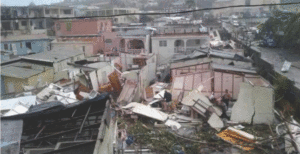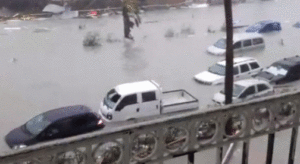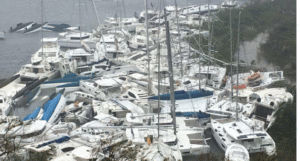
 SAN JUAN, Puerto Rico — Heavy rain and 185-mph winds lashed the Virgin Islands and Puerto Rico’s northeast coast yesterday as Hurricane Irma roared through Caribbean islands on its way to a possible hit on South Florida.
SAN JUAN, Puerto Rico — Heavy rain and 185-mph winds lashed the Virgin Islands and Puerto Rico’s northeast coast yesterday as Hurricane Irma roared through Caribbean islands on its way to a possible hit on South Florida.
The strongest Atlantic Ocean hurricane ever measured destroyed homes and flooded

streets across a chain of small islands in the northern Caribbean, passing directly over Barbuda and leaving the island of some 1,700 people incommunicado.
France sent emergency food and water rations to the French islands of Saint Martin and Saint Barthelemy, where Irma ripped off roofs and knocked out all electricity. Dutch marines who flew to three Dutch islands hammered by Irma reported extensive damage but no deaths or injuries.
While France received no immediate reports of casualties, the minister for French overseas territories, Annick Girardin, said: “We have a lot to fear for a certain number of our compatriots who unfortunately didn’t want to listen to the protection measures and go to more secure sites … We’re preparing for the worst.”
By early yesterday afternoon the center of the storm was 20 miles (35 kilometers) east-southeast of St. Thomas in the U.S. Virgin Islands and 90 miles (150 kilometers) east of San Juan, Puerto Rico and heading west-northwest at 16 mph (26 kph).
The U.S. National Weather Service said Puerto Rico had not seen a hurricane of Irma’s magnitude since Hurricane San Felipe in 1928, which killed a total of 2,748 people in Guadeloupe, Puerto Rico and Florida.
“The dangerousness of this event is like nothing we’ve ever seen,” Puerto Rico Gov. Ricardo Rossello said. “A lot of infrastructure won’t be able to withstand this kind of force.”
The federal government has stepped in, with President Donald Trump this week approving an emergency declaration for the U.S. Virgin Islands and Puerto Rico. That means that the Federal Emergency Management Agency and other agencies can remove debris and give other services that will largely be paid for by the U.S. government.
The U.S. National Hurricane Center said Irma’s winds would fluctuate, but the storm would likely remain at Category 4 or 5 for the next day or two as it roared past Puerto Rico, the Dominican Republic, Haiti, Cuba, the Turks & Caicos and parts of the Bahamas.
By early Sunday, Irma is expected to hit Florida, where Gov. Rick Scott said he planned to activate 7,000 National Guard members by Friday and warned that Irma is “bigger, faster and stronger” than Hurricane Andrew. which
pummeled south Florida 25 years ago and wiped out entire neighborhoods with ferocious winds.
President Trump also declared an emergency in Florida and authorities in the Bahamas said they would evacuate six southern islands.
The State Department authorized voluntary evacuation of U.S. diplomats and their families from Cuba, where the storm was expected to arrive by Friday.
MIT meteorology professor Kerry Emanuel, an expert in hurricanes, calculated that the amount of energy in Hurricane Irma is about 7 trillion watts, about twice the energy of all bombs used in World War II. He said it close to how much energy people use around the world. Pennsylvania State University meteorology professor Paul Markowski estimated it could be three times that.
Warm water is fuel for hurricanes and Irma was moving over water that was 1.8 degrees (1 degree Celsius) warmer than normal. The 79 degree (26 Celsius) water that hurricanes need went about 250 feet (80 meters) deep, said Jeff Masters, meteorology director of the private forecasting service Weather Underground.
Four other storms have had winds as strong in the overall Atlantic region, but they were in the Caribbean Sea or the Gulf of Mexico, which usually have warmer waters. Hurricane Allen hit 190 mph in 1980, while 2005’s Wilma, 1988’s Gilbert and a 1935 great Florida Keys storm all had 185 mph winds.
Bahamas Prime Minister Hubert Minnis said his government was evacuating six islands because authorities would not be able to help anyone caught in the “potentially catastrophic” wind, flooding and storm surge. People there would be flown to Nassau in what he called the largest storm evacuation in the country’s history.
The northern parts of the Dominican Republic and Haiti could see 10 inches (25 centimeters) of rain, with as much as 20 inches (50 centimeters) in the southeast Bahamas and Turks and Caicos.


